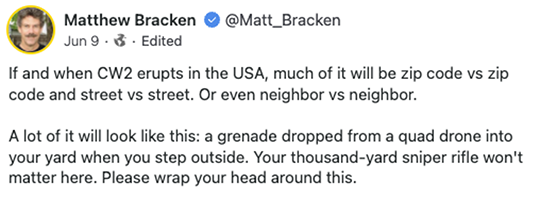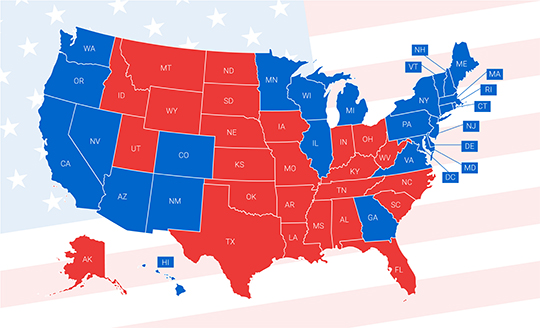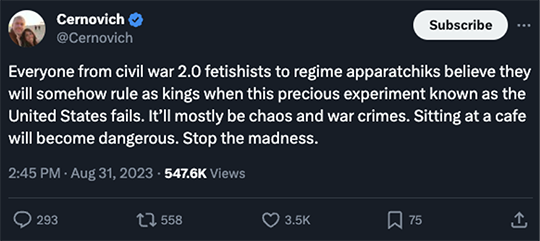“Blood Trains”
![]() Thinking About Civil War
Thinking About Civil War
 This is an issue of our 5 Bullets I don’t want to write — although I’ve anticipated doing so for several years.
This is an issue of our 5 Bullets I don’t want to write — although I’ve anticipated doing so for several years.
I certainly don’t want to write about it with the holidays approaching. Then again, this might be the last time you and I get to experience “normal” holidays for a while.
Anyway, when I encountered this last week, I knew the time had come…

According to IMDb, Civil War starring Kirsten Dunst is tentatively set for release on April 26 next year. It’s shot in IMAX, so it must have a helluva budget.
The movie might well arrive at a theater near you at the very moment of Biden impeachment hearings and Trump criminal trials. Good times.
 In a not-unrelated development, “a new poll of nearly 300 former members of Congress reveals deep concerns about the threat of political violence ahead of the 2024 election,” according to the MassLive website.
In a not-unrelated development, “a new poll of nearly 300 former members of Congress reveals deep concerns about the threat of political violence ahead of the 2024 election,” according to the MassLive website.
The University of Massachusetts Amherst recently conducted the poll along with the U.S. Association of Former Members of Congress. (No, I didn’t know such a thing existed, either.)
All told, 94% of Democrats and 74% of Republicans said they worry about the prospect of political violence. In addition, 46% of Democrats and 49% of Republicans said they “regularly” face threats against themselves or their families.
 To be sure, this isn’t the first time your editor has pondered a new American civil war, or what it might mean for the economy and the markets.
To be sure, this isn’t the first time your editor has pondered a new American civil war, or what it might mean for the economy and the markets.
The first time was after the unfortunate events in Charlottesville, Virginia, in August 2017. The protests, counter-protests and murder-by-automobile weren’t exactly like Fort Sumter in 1861 — but they struck me as analogous to Harpers Ferry in 1859, or an earlier incident in “Bleeding Kansas.”
We cited Georgia State professor Jennifer McCoy. “When voters divide into opposing camps,” she told NPR, “they come to view the other side not any longer as a political adversary… but instead as a threatening enemy to be vanquished.”
Coincidentally or not, the stock market hiccupped in the days that followed. Rumor had it that Gary Cohn, Donald Trump’s chairman of the White House National Economic Council, was about to resign in protest…

The rumors were unfounded. The tension after Charlottesville returned from a boil to a simmer. The stock market resumed its steady march higher that year. Cohn left the administration a few months later in a disagreement over trade policy.
 The problem with many Americans’ thinking about a second civil war is that it’s warped by the experience of the first.
The problem with many Americans’ thinking about a second civil war is that it’s warped by the experience of the first.
“We didn’t really have a civil war,” tweets Darryl Cooper, the man behind the extraordinary Martyr Made history podcasts. “We split into two countries and had a regular war.”
Exactly. Most civil wars do not entail set-piece battles by uniformed soldiers. How likely is that now, really?
“Civil war looks like Beirut or Sarajevo,” Cooper continues, “where you couldn’t walk outside for fear of being randomly sniped, and there were no pitched battles, just kidnappings, assassinations and basement torture sessions.”
Again in 2017, we cited the prepper writer John Mosby (which may or may not be a pen name): “This is about people burning down their neighbors’ houses and businesses, to run them out of town, over ideological differences. Look at the Balkans in the early 1990s. This is about a group from one side, murdering the entire family — Dad, Mom, brother and baby Sister — of their neighbors, over political differences.”
And unlike some of the previous civil wars we’re about to describe by way of example, a new American civil war would come with a novel element — inexpensive drones. Here’s a former Navy SEAL with sobering food for thought addressed to hard-core prepper types…

Well, no, it’s very hard to wrap one’s head around this — no matter how much or how little experience you have with a thousand-yard sniper rifle.
 “The trigger that starts the conflict could be almost anything,” writes demographer and historian Neil Howe in his 2023 book The Fourth Turning Is Here.
“The trigger that starts the conflict could be almost anything,” writes demographer and historian Neil Howe in his 2023 book The Fourth Turning Is Here.
Howe has spent decades contemplating the crises that seem to beset Anglo-American societies every 80 years or so, going back to the War of the Roses in the 15th century.
“It could start at the top with an impeachment, a contested national election, a Supreme Court decision or a complete breakdown of House or Senate protocol.
“Or it could start at the bottom with several states refusing to comply with federal rules and beginning to set their own social, economic, immigration or environmental policies.
“Whatever the trigger, the conflict would gradually gain momentum through a series of standoffs, ultimatums and shows of force. And it would likely escalate, against most leaders’ original intentions, into large-scale organized violence.”
And then what?
For our next three bullets today, we look at recent history abroad to glean the possibilities. There’s a bad scenario… a worse scenario… and a worst scenario.
![]() Bad Scenario: Northern Ireland, “The Troubles”
Bad Scenario: Northern Ireland, “The Troubles”
 The least-worst scenario is the Catholic-vs.-Protestant conflict in Northern Ireland known as “The Troubles” — which dragged on for 30 years.
The least-worst scenario is the Catholic-vs.-Protestant conflict in Northern Ireland known as “The Troubles” — which dragged on for 30 years.
There’s no obvious starting point for The Troubles. Some historians have settled on 1968, maybe because that was a year of epic conflict and political violence worldwide — including the United States.
There’s more agreement on the endpoint — the Good Friday Agreement of 1998, approved by voters in both Northern Ireland and the Republic of Ireland.
According to Wikipedia, the death toll across those three decades totaled 3,532 — a little over half of them civilians. The number of injured totaled 47,500.
Even one death is a tragedy, but those totals sound fairly modest, right?
But hold on: Northern Ireland’s population is tiny. At the midpoint of the conflict in 1983, the population was 1,550,600.
America’s population today is 340 million. If you extrapolate the death toll from the Troubles to present-day America, that’s a death toll of over 774,000 — about the same number of people who live in a typical congressional district.
Across a 30-year conflict, that’s over 25,800 people every year. If the conflict is compressed into a smaller timeframe, the per-year figure grows.
![]() Worse Scenario: Partition of India
Worse Scenario: Partition of India
 Perhaps a more realistic example — and a more sobering one — is the partition of India in 1947. It’s the one we’ll spend the most time on today.
Perhaps a more realistic example — and a more sobering one — is the partition of India in 1947. It’s the one we’ll spend the most time on today.
The British Empire was dead-ass broke at the end of World War II. It had no money to retain control over what was long considered the empire’s “crown jewel,” India.
But an independent India would not exist as a single entity. The Hindu part became a country called India… while the two Muslim parts on either side of it became a country called Pakistan. (East Pakistan subsequently seceded from the west, becoming Bangladesh in 1971.)
 Alas, millions of Hindus and Muslims found themselves on the “wrong” side of the borders that were drawn — largely by the British — in 1947. So they had to pick up stakes and move.
Alas, millions of Hindus and Muslims found themselves on the “wrong” side of the borders that were drawn — largely by the British — in 1947. So they had to pick up stakes and move.
In no way was this a seamless process.
“Homes were set on fire and looted,” wrote Tavleen Tarrant for Al Jazeera’s website in 2021. “Trains shuffling refugees back and forth between the newly formed nations were filled with corpses and gangs of vengeful men armed with swords. Massacres en route were commonplace. According to a report by the Australian Associated Press in September 1947, one massacre left 3,000 Muslim passengers dead. Reports of trains dripping in blood and railways blanketed with the dead led to these treacherous journeys becoming known as ‘blood trains.’
“Women drowned themselves to avoid being raped, their bloated bodies floating through contaminated, blood-stained rivers. The acrid scent of death and destruction embedded itself into the nations’ topography.
“My grandmother, however, never spoke of any of this. When asked about Partition, she would answer just that ‘bad things happened.’”
An estimated one million people died. Between 10–20 million were displaced. Call it 15 million for our purposes.
The population of pre-partition India was 409.2 million — not much larger than the present-day U.S. population of 340 million.
The India model translates to a U.S. equivalent of 831,000 dead and 12.5 million displaced — much of that within the space of only a few months. The number of refugees would roughly equal the population of Illinois.
 Perhaps the thought has crossed your mind already: If America’s “red” and “blue” states go their own way, a lot of people would find themselves on the “wrong” side of the new borders.
Perhaps the thought has crossed your mind already: If America’s “red” and “blue” states go their own way, a lot of people would find themselves on the “wrong” side of the new borders.
Chew on this map of the 2020 election results and ponder the possibilities: Would conservatives in Illinois have to move to Indiana? Would liberals in the Intermountain West have to move to the Pacific Northwest? And then what about conservatives in the eastern portions of the Pacific Northwest? (Already there’s a move afoot for that region to join up with a “Greater Idaho.”)

And that doesn’t even address the geographically scattered “purple” states. These are the half-dozen or so that political prognosticators call the “battleground” states — which may not be merely a figure of speech much longer.
What happens to those people — especially in Arizona, Georgia and Wisconsin? Fewer than 43,000 votes spread across those three states made the difference between a Biden victory and a Trump victory.
And this scenario assumes there are only two sides in whatever conflict breaks out…
![]() Worst Scenario: Breakup of Yugoslavia
Worst Scenario: Breakup of Yugoslavia
 However, if the United States starts to crack up amid more than two factions, we’re then potentially looking at a worst-case scenario — the breakup of Yugoslavia.
However, if the United States starts to crack up amid more than two factions, we’re then potentially looking at a worst-case scenario — the breakup of Yugoslavia.
Northern Ireland and the partition of India were, by and large, two-sided affairs.
In contrast, the breakup of Yugoslavia was a messy, complicated thing — Croatians versus Serbians, Serbians versus Bosnian Muslims, Kosovar Muslims versus Serbians, Macedonians versus Macedonians…
For decades after World War II, this pastiche of ethnicities was held together by the strongman Josip Broz Tito. Tito died in 1980; a decade later, Yugoslavia began to fly apart.
What was a single country in 1991 was five countries — or arguably six — a decade later.
The Yugoslav city of Sarajevo hosted the Winter Olympics in 1984. By the mid-’90s, it was the capital of Bosnia-Herzegovina — and it was a smoldering wreck.
Yugoslavia’s population in 1991 was 23,528,230. The death toll over the ensuing 10 years is estimated between 130,000–140,000. Extrapolating that number to present-day America, the dead would number 1,951,000.
The number of displaced was a staggering 4 million — fully one-sixth of the population. The U.S. equivalent? 57,803,000. That’s more than the populations of Texas and Florida combined.
![]() Civil Wars, Markets and Supply Chains
Civil Wars, Markets and Supply Chains
 For our purposes today, we’ll leave aside an even more dire scenario than the breakup of Yugoslavia — one that Darryl Cooper hinted at above.
For our purposes today, we’ll leave aside an even more dire scenario than the breakup of Yugoslavia — one that Darryl Cooper hinted at above.
The multisided civil war in Lebanon dragged on from 1975–1990. The dead numbered about 135,000, comparable to the Balkans conflict. But Lebanon was a much smaller country than the former Yugoslavia — about 3.1 million people at the conflict’s midpoint in 1983.
That said, what sets the Lebanese civil war apart from these other conflicts was the nearly nonstop intervention by the militaries of other countries — especially Israel and Syria, not to mention a misbegotten “peacekeeping” mission by the United States that ended with 241 dead Marines.
At least at this point in time, the likelihood of other countries intervening in a U.S. civil war seems remote — the Red Dawn fantasies of a few patriot/prepper types notwithstanding.
It’s more likely that other countries would take advantage of a divided America to settle scores with their own neighbors. To be sure, that’s a scary scenario — China vs. India or India vs. Pakistan could easily go nuclear — but our considerations today are closer to home.
Speaking of India and Pakistan again…
 Assuming a breakup of America into “red” and “blue,” that still wouldn’t be the end of the story — not given the relevant experience of India.
Assuming a breakup of America into “red” and “blue,” that still wouldn’t be the end of the story — not given the relevant experience of India.
The partition of India entailed a full-on war between India and Pakistan in late 1947 and early 1948. The two countries fought subsequent wars in 1965 and 1971. They’re still at loggerheads over the fate of Kashmir, India’s only Muslim-majority state. Since 1998, both countries have had nukes.
Back in the United States, too many people on “both” sides delude themselves…

 Teasing out the financial implications of a second American civil war is a dicey affair.
Teasing out the financial implications of a second American civil war is a dicey affair.
Back in 2017, I joked grimly about how the only asset classes that would thrive in such an environment would be precious metals, ammo and No. 10 Mountain House cans.
The reality is that many asset classes might be subject to extreme booms and busts. Here, perhaps the experience of the first Civil War would be instructive. In May 1863, Wall Street experienced a bull market known as the “Chancellorsville rise” — after a Confederate victory in Virginia that racked up more than 17,000 Union casualties. The market rallied on the theory that with the war lasting longer than expected, the Union government would have to issue more inflationary “greenbacks.”
Easy money fueling a bull market. Sound familiar?
More recently, and for no obvious reason, the Dow industrials rallied 400 points to a record close on Jan. 6, 2021 — the day of the U.S. Capitol riot.
Of greater concern than asset prices would be the stability of the power grid, the internet and supply chains. The first two would be vulnerable to sabotage; the last would be vulnerable to sabotage and the more general problem of moving goods from Point A to Point B amid armed conflict.
We’ll leave it there for today. As I said off the top, I take no pleasure in writing about these matters. But as always, it’s best to think about a potential crisis before it becomes front-page news. And as always, we’ll aim to stay ahead of the curve into 2024…
Best regards,

Dave Gonigam
Managing editor, Paradigm Pressroom's 5 Bullets
P.S. Speaking of snarled supply chains, that’s the most meaningful market story today — even if you have to scroll down on the home pages of both CNBC and The Wall Street Journal to see it.
BP is halting all oil shipments through the Red Sea. That means they’re going to have to take the looong way around the bottom of Africa.
The ethnic Houthi faction in Yemen has been attacking merchant shipping bound for Israel in recent days; the operators of ships headed for other destinations don’t want to be anywhere in harm’s way.
Even before BP made its move, several of the big container-shipping lines like Maersk and Hapag-Lloyd took the same step.
And so, crude is up more than 3% on the day to $73.66. (On the more peaceful side of the ledger, Venezuela and Guyana have signed an agreement to resolve their dispute over the oil-rich Essequibo region without armed force.)
All the major U.S. stock indexes are in the green, the S&P 500 by nearly half a percent to 4,739. Apple is down 1.4% on news that it will halt all smartwatch sales only days from now to comply with a U.S. import ban. Meanwhile, U.S. Steel is up 27% on a takeover bid from Japan’s Nippon Steel.
Precious metals are quiet, gold at $2,022 and silver at $23.74.
Thanks for indulging us one of our occasional deep-dive forays into a single topic; back to regularly scheduled programming tomorrow.










